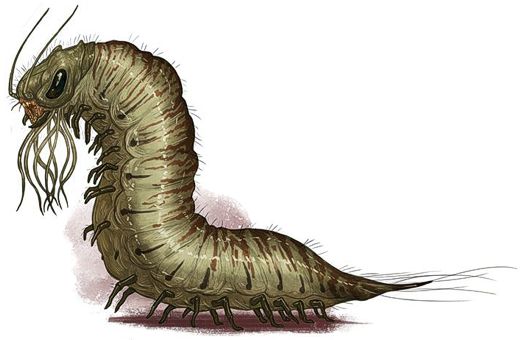

Monstrous Manual

| Climate/Terrain: | Subterranean |
|---|---|
| Frequency: | Uncommon |
| Organization: | Solitary |
| Activity Cycle: | Any |
| Diet: | Carnivore |
| Intelligence: | Non- (0) |
| Treasure: | B |
| Alignment: | Neutral |
| No. Appearing: | 1-6 |
| Armor Class: | 3/7 |
| Movement: | 12 |
| Hit Dice: | 3+1 |
| THAC0: | 17 |
| No. of Attacks: | 8 or 1 |
| Damage/Attack: | Special or 1-2 |
| Special Attacks: | Paralysis |
| Special Defenses: | Nil |
| Magic Resistance: | Nil |
| Size: | L (9’ long) |
| Morale: | Special |
| XP Value: | 420 |
The carrion crawler is a scavenger of subterranean areas, feeding primarily upon carrion. When such food becomes scarce, however, it will attack and kill living creatures.
The crawler looks like a cross between a giant green cutworm and a cephalopod. Like so many other hybrid monsters, the carrion crawler may well be the result of genetic experimentation by a mad, evil wizard.
The monster’s head, which is covered with a tough hide that gives it Armor Class 3, sprouts eight slender, writhing tentacles. The body of the carrion crawler is not well protected and has an armor class of only 7. The monster is accompanied by a rank, fetid odor which often gives warning of its approach.
Combat: The carrion crawler can move along walls, ceilings and passages very quickly, using its many clawed feet for traction.
When attacking, the monster lashes out with its 2’ long tentacles, each of which produces a sticky secretion that can paralyze its victims for 2-12 turns. A save versus paralyzation is allowed to escape these effects. They kill paralyzed creatures with their bite which inflicts 1-2 points of damage. The monster will always attack with all of its tentacles.
Carrion crawlers are non-intelligent, and will continue to attack as long as any of their opponents are unparalyzed. Groups of crawlers attacking together will not fight in unison, but will each concentrate on paralyzing as many victims as they can. When seeking out prey, they rely primarily on their keen senses of sight and smell. Clever travelers have been known to fool an approaching carrion crawler with a sight and smell illusion, thus gaining time to make good their escape.
Habitat/Society: Carrion crawlers are much-feared denizens of the underground world. They live in lairs, venturing out in search of carrion or food every few days. Some underground inhabitants such as goblins and trolls will make use of carrion crawlers by leaving the bodies of dead foes out in designated areas. This keeps the creatures at a good distance from their own homes and encourages them to “patrol” certain areas. Some orcs have been known to chain live prisoners near the lairs of these fearsome monsters.
Carrion crawlers will sometimes live with a mate or in a small group numbering no more than 6. This does not mean that they cooperate in hunting, but merely share the same space and compete fiercely for the same food. If two crawlers have made a kill or discovered carrion, they will often fight over the food, sometimes killing one another in the process.
The carrion crawler mates once a year. Several days after mating, the female will go off in search of a large kill. When she has found or killed an adequate food supply, she lays about 100 eggs among the carrion. The grubs hatch one week later and begin feeding.
Maternal care ceases once the eggs have been laid and it is not uncommon for eggs to later be eaten by the female who laid them. Females die a few weeks after laying their eggs, exhausted by the effort. Males live only a short time longer, having mated with as many females as possible. Grubs have been known to consume one another in feeding frenzies, and are a favorite food of adult carrion crawlers. Few of the grubs reach maturity, but those who do have eaten voraciously and will achieve their full size in a single year. When they reach maturity, the mating cycle begins again.
These monsters exist on the most basic instinctual level, having no more intelligence than earthworms or most insects. The carrion crawler is driven by two urges: food and reproduction. It has absolutely no interest in the collection of treasure.
Ecology: The carrion crawler provides the same useful, if disagreeable, function that jackals, vultures, and crows perform. Like so many other predators carrion crawlers instinctively prey on the weak, sick, and foolish. In the long run, this has a beneficial effect on the prey, strengthening its gene pool. The carrion crawler also works wonders in over crowded caverns, quickly eliminating population problems among the weaker monsters. Thus, the life cycle of the crawler is inextricably linked to those of its prey – when the prey flourishes so does the crawler.
